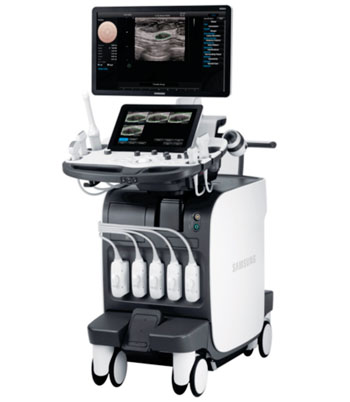Ultrasound System Designed with Breast and Thyroid Scanning Capabilities
By MedImaging International staff writers
Posted on 13 Aug 2014
An ultrasound system, entering radiology market for the first time, offers advanced tools in display and functions that enhance diagnostic effectiveness and usability.Posted on 13 Aug 2014
Samsung Medison (Seoul, Republic of Korea), an international manufacturer of medical devices recently launched the RS80A, ultrasound system designed for diagnosis in the radiology department. The RS80A featuring Samsung Electronics’ high-tech information technology (IT) and imaging functions is Samsung Medison’s first product to target the radiology segment, which is the largest portion in diagnostic imaging market.

Image: The RS80A ultrasound system is designed for diagnosis in the radiology department (Photo courtesy of Samsung Medison).
The RS80A offers greater diagnostic confidence and accuracy through the latest innovations in imaging and usability. Its key features include excellent image quality; a 23-inch full high-definition (FHD) light-emitting diode (LED) screen; S-Vision architecture, which provides very clear images through newly developed S-Vision beamformer and imaging engine. These ensure detailed resolution and tissue uniformity for all types of applications in radiology and general imaging; and finally, the S-Vue transducer feature offers a broader bandwidth and higher sensitivity to enable excellent image quality at depth.
Samsung Medison has expanded its probe range to support diagnosis over various areas such as thorax, abdomen, carotid, and thyroid.
Other features of the technology includes the S-Detect, which uses the standardized Breast Imaging-Reporting and Data System (BI-RADS) score for analysis and classification of targeted regions. The S-Detect tool results in more effective diagnosis by reducing unnecessary biopsies and saving time through simplified procedures.
The E-Breast and E-Thyroid ElastoScan (elastography) makes it easier for users to differentiate benign from malignant masses through acquiring the strain ratio between the target and reference area faster than before.
The advanced QuickScan allows important imaging parameters to be automatically adjusted, such as location of the color box, color gain, and angle correction. The system’s intuitive design includes a three-dimensional (3D) Navigator and fewer keys on the control panel allows for ease of use and greater examination throughput. Users are given more operating space because keyboard is embedded into the touch screen. The device can remember user’s position and height of the control panel every time they run the system.
“Samsung is finally putting its feet into the radiology market thanks to the launch of RS80A. We are confident that this premium system will provide users a new level of diagnostic quality and convenience,” said Soo-in Cho, CEO of Samsung Medison. “Samsung will continue to put its best efforts towards developing medical devices that deliver true-to-life images and features that provide faster diagnosis.”
Samsung Medison markets diagnostic ultrasound devices worldwide across various medical fields. The company attracted global attention in 2001 through the introduction of Live 3D technology.
Related Links:
Samsung Medison













.jpg)
